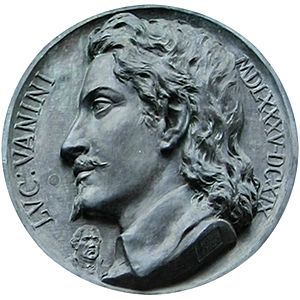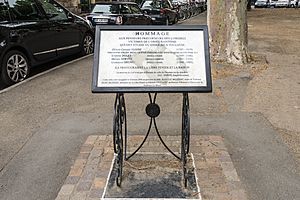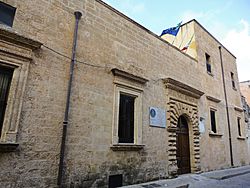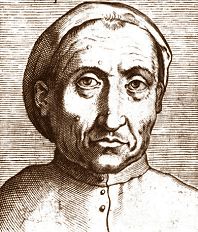Lucilio Vanini facts for kids
Quick facts for kids
Lucilio "Giulio Cesare" Vanini
|
|
|---|---|

Medallion by Ettore Ferrari on base of Giordano Bruno statue, Campo de' Fiori, Rome
|
|
| Born | 1585 Taurisano, Terra d'Otranto, Italy
|
| Died | 9 February 1619 (aged 33) Toulouse, France
|
| Nationality | Italian |
| Era | 17th-century philosophy |
| Region | Western philosophy |
| School | Rationalism, humanism, libertinism |
|
Main interests
|
Metaphysics, science, religion |
|
Notable ideas
|
Nomological determinism, God as a vital force in Nature (pantheism), humans and non-human apes have common ancestor; denied immortality of the soul |
|
Influences
|
|
|
Influenced
|
|
Lucilio Vanini (1585 – 9 February 1619), also known as Giulio Cesare Vanini, was an Italian thinker. He was a philosopher, doctor, and a free-thinker. He is known as one of the first important people to represent intellectual libertinism.
Vanini was among the first modern thinkers to believe the universe worked by natural laws. This idea is called nomological determinism. He also wrote about biological evolution. He suggested that humans and other apes might share common ancestors. Vanini was executed in Toulouse, France, for his ideas.
Contents
Lucilio Vanini's Life Story
Early Years and Studies (1585–1612)
Lucilio Vanini was born in 1585 in Taurisano, Italy. He started studying at the University of Naples in 1599. In 1603, he joined the Carmelite order and took the name Fra Gabriele. He earned a special degree in law from the University of Naples in 1606.
After his studies, he spent two years near Naples. He also studied new Renaissance sciences like medicine and astronomy. Like Giordano Bruno, he challenged the old ways of thinking taught in schools.
Travels and Challenges (1608–1614)
Around 1608, Vanini moved to Padua, a city in Venice. There, he studied theology and met a group led by Paolo Sarpi. This group was against the Pope's power. Vanini supported the Republic of Venice during a conflict with the Pope. Because of this, his religious order wanted him to return to Naples for punishment. Instead, Vanini found safety with the English ambassador in Venice in 1612.
Vanini then went to England with a friend. They stayed there for almost two years. In July 1612, they left the Catholic faith and joined the Anglican Church. However, by 1613, Vanini wanted to return to Catholicism. He asked the Pope for permission, which was granted. In early 1614, Vanini and his friend were arrested in London. But they both managed to escape soon after.
Life in France (1614–1618)
In the summer of 1614, Vanini arrived in Paris. He confirmed his return to the Catholic faith. He then traveled to Italy, going to Rome and Genoa. In Genoa, he taught philosophy for a few months.
However, Vanini's friend was arrested in Genoa. Fearing the same, Vanini fled back to France. In June 1615, he published a book called Amphitheatrum. This book was against atheism, and he hoped it would clear his name with the Church.
Vanini returned to Paris and tried to get help from Church officials. He decided not to go back to Italy and instead made friends with important French nobles.
In 1616, Vanini finished his second book, De Admirandis Naturae. Two theologians from the Sorbonne University approved it. The book was published in Paris in September. It became popular among young, open-minded people interested in new ideas. However, the Sorbonne later banned the book.
Vanini was no longer welcome in England, could not return to Italy, and faced threats in France. He went into hiding in Brittany. In 1617, a political event in Paris caused more trouble for Italians at court.
Final Year and Execution (1618–1619)
In the following months, a mysterious Italian man appeared in different cities in France. He had a lot of knowledge but a hidden past. This person was Vanini, using a different name. He was protected by a powerful duke.
However, his presence in Toulouse was noticed by authorities. In August 1618, he was arrested and questioned. In February 1619, a court in Toulouse found him guilty of atheism and blasphemy. He was executed on February 9, 1619. After his execution, it was confirmed that the stranger was indeed Vanini.
Vanini's Important Works
Amphitheatrum
Vanini's first book, Amphitheatrum Aeternae Providentiae, was published in Lyon in 1615. It has 50 sections. In this book, Vanini tried to show that God exists. He also discussed God's nature and how God cares for the world. He looked at and disagreed with the ideas of many ancient philosophers on these topics.
De Admirandis Naturae
His second book, De Admirandis Naturae Reginae Deaeque Mortalium Arcanis, was printed in Paris in 1616. It is divided into four parts:
- On Sky and Air
- On Water and Land
- On Animals and Passions
- On Non-Christian Religions
This book contains 59 dialogues. In these dialogues, Vanini explains the mysteries of nature. He talks about the sky, sun, moon, stars, and weather. He also discusses water, land, animals, and human feelings. He mixes old knowledge with new scientific and religious ideas.
Vanini's Ideas
Vanini was greatly influenced by Pietro Pomponazzi, whom he called his "divine master." Pomponazzi had explained supernatural events using natural reasons. Vanini continued this idea in De Admirandis Naturae. He also referred to other thinkers like Gerolamo Cardano.
Vanini believed that God works through the sky to affect humans. This meant that seemingly supernatural events could have natural and logical explanations. He also thought that human imagination could change how we see reality. Vanini believed that some religious leaders created false beliefs to gain power. He thought that "all religious things are false and fake principles to teach the naive populace."
Following Pomponazzi, Vanini questioned the idea of the soul living forever. He also disagreed with the old idea that the Earth was the center of the universe. Like Giordano Bruno, he believed that the everyday world and the celestial world were made of the same changeable material.
Vanini also suggested a new way to describe the universe. He compared bodies to a watch, working like a machine. He also thought about how living things might change over time. This was an early idea of biological evolution. He believed that the Earth rotates and supported the idea that the Sun is the center of our solar system.
Vanini's ideas were often hidden in his writings to avoid trouble with religious and political leaders. Because of this, understanding his exact thoughts can be hard. However, he is often seen as someone who doubted traditional beliefs or even as an atheist. He is considered one of the founders of libertinism.
Vanini's ideas came from the Renaissance period. He combined old Aristotelian ideas with elements of mysticism. He also took ideas from Nicholas of Cusa, similar to Giordano Bruno, about God being in nature. Vanini believed that matter was eternal. He saw God as a "force" within nature that shapes and directs everything. He thought that all life forms came from the Earth itself.
Although Vanini was called an atheist, his first book, Amphitheatrum, suggests otherwise. He thought that the founders of the three main religions – Moses, Jesus, and Muhammad – were just "impostors."
In De Admirandis, Vanini further developed his ideas. He did not believe in creation from nothing or the soul living forever. He saw God as the driving and vital force within Nature, both being eternal. He considered the stars as a link between God and Nature. For him, true religion was a "religion of Nature" that saw God as a spirit-force.
Vanini's writings show a strong anti-clerical feeling. One of his original ideas was an early form of Darwinism. He first suggested that animal species appeared spontaneously from the Earth. Later, he seemed to believe that species could change into each other. He even thought that humans came from "animals related to man, such as the Barbary apes, the monkeys and apes in general."
Vanini's Legacy
After Vanini's death, two books published in 1623 helped create the idea of Vanini as an atheist. These books, by Jesuit François Garasse and Father Marin Mersenne, actually made his ideas more widely known.
In 1624, Marin Mersenne attacked Vanini's philosophy again. Even Leibniz, another famous philosopher, strongly disagreed with Vanini, calling him evil.
English thinkers became interested in Vanini's ideas. Through the work of Charles Blount, Vanini's thoughts became important in English culture. They influenced libertinism and deism in the 17th century.
In 1730, a biography of Vanini was published in London. It discussed his ideas and recognized their value. Later, Arthur Schopenhauer, a German philosopher, included Vanini among thinkers who believed that everything happens out of necessity.
See also
 In Spanish: Lucilio Vanini para niños
In Spanish: Lucilio Vanini para niños






